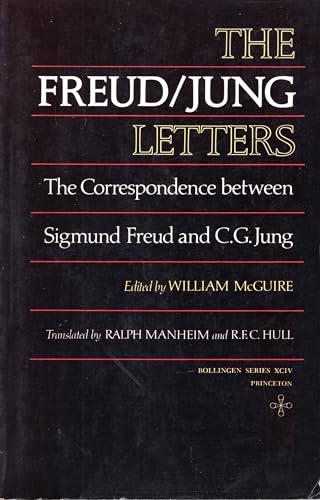Verwandte Artikel zu The Freud/Jung Letters: The Correspondence Between...
The Freud/Jung Letters: The Correspondence Between Sigmund Freud and C. G. Jung: 62 (Bollingen Series) - Hardcover

Inhaltsangabe
In April 1906, Sigmund Freud wrote a brief note to C. G. Jung, initiating a correspondence that was to record the rise and fall of the close relationship between the founder of psychoanalysis and his chosen heir. This correspondence is now available for the first time, complete except for a few missing letters apparently lost long ago.
The letters, some 360 in number, span seven years and range in length from a postcard to a virtual essay of 1,500 words. In accordance with an agreement between the writers' sons, Ernst Freud and Franz Jung, the letters are published as documents, without interpretation, but with a detailed annotation that identifies more than 400 persons, 500 publications, and many literary and topical allusions.
Anna Freud comments, "[The annotation] has turned the correspondence truly into a history of the beginnings of psychoanalysis, something that was very much needed and is not given anywhere else with the same attention to detail and inclusion of all the people in public life who cither came to psychoanalysis for a while or turned violently against it from the beginning. . . . Every detail is necessary and enhances the value of the book."
There are appendixes, facsimiles, and contemporary photographs. The index, with bibliographical details, is exhaustive.
As historical documents, the letters reflect the early struggles of Freud and Jung in gaining acceptance for psychoanalysis. Freud, Jung's senior by twenty years, patiently assesses the opposition, cautioning the fiery Jung to concentrate more on his research than on answering the critics. The two exchange candid opinions on their colleagues, plan strategies for the advancement of their cause, and most important, share their experiences with patients and with the reading that led them to new scientific realizations.
The correspondence provides an account of the composition of many papers, lectures, and books of Freud, Jung, and their colleagues, and describes the genesis of the journals, conferences, and international and local societies of the movement.
The decline of the correspondence documents Jung's increasing reluctance to accept the entire Freudian code, and the growing bitterness that led to the mutual decision to end the correspondence and the relationship.
Die Inhaltsangabe kann sich auf eine andere Ausgabe dieses Titels beziehen.
Von der hinteren Coverseite
'The substance of intellectual history at a turning point is in these letters. The impression is of two immensely ambitious, self-willed, often inspired men, who had set themselves apart as innovators, roped together in a long climb into a new world.' -The Observer
„Über diesen Titel“ kann sich auf eine andere Ausgabe dieses Titels beziehen.
EUR 3,43 für den Versand innerhalb von/der USA
Versandziele, Kosten & DauerNeu kaufen
Diesen Artikel anzeigenEUR 3,87 für den Versand innerhalb von/der USA
Versandziele, Kosten & DauerSuchergebnisse für The Freud/Jung Letters: The Correspondence Between...
The Freud / Jung Letters: The Correspondence between Sigmund Freud and C.G. Jung
Anbieter: Southampton Books, Sag Harbor, NY, USA
Hardcover. Zustand: Very Good. First Edition. First Edition, First Printing. Not price-clipped. Published by Princeton University Press, 1974. Octavo. Hardcover. Book is very good with light spotting to the top page ends. Dust jacket is very good with a small tear at the top of the spine and light edgewear.100% positive feedback. 30 day money back guarantee. NEXT DAY SHIPPING! Excellent customer service. Please email with any questions. All books packed carefully and ship with free delivery confirmation/tracking. All books come with free bookmarks. Ships from Sag Harbor, New York. Artikel-Nr. 326707
Anzahl: 1 verfügbar
The Freud / Jung Letters The Correspondence between Sigmund Freud and C. G. Jung
Anbieter: True Oak Books, Highland, NY, USA
Hardcover. Zustand: Very Good-. Zustand des Schutzumschlags: Good. Translation. Bollingen Series, No. 94; 6.5 X 1.75 X 9.5 inches; 650 pages; minimal foxing on the top exterior edge of textblock. Few minor, faint smudges on the exterior edges of textblock. Moderate creasing and shelf wear on DJ. Minor tears on DJ's spine head. Very Good condition otherwise. No other noteworthy defects. No markings. ; Your satisfaction is our priority. We offer free returns and respond promptly to all inquiries. Your item will be carefully cushioned in bubble wrap and securely boxed. All orders ship on the same or next business day. Buy with confidence. Artikel-Nr. HVD-65585-A-0
Anzahl: 1 verfügbar
The Freud / Jung Letters: The Correspondence between Sigmund Freud and C.G. Jung (Bollingen Series, No. 94)
Anbieter: Labyrinth Books, Princeton, NJ, USA
Zustand: New. Artikel-Nr. 142233
Anzahl: 1 verfügbar
The Freud/Jung Letters: The Correspondence between Sigmund Freud and C. G. Jung
Anbieter: Kennys Bookstore, Olney, MD, USA
Zustand: New. Jung's break with Freud is one of the most famous stories in the early history of psychoanalytic thought. As late as 1959, Jung was moved to refer to the letters as "that accursed correspondence." This work serves as a testament to the diplomacy and persistence of William McGuire, executive editor for "Bollingen Series". Editor(s): McGuire, William. Series: Bollingen Series. Num Pages: 650 pages. BIC Classification: JMAF. Category: (P) Professional & Scholarly; (U) Tertiary Education (US: College). Dimension: 236 x 161 x 48. Weight in Grams: 1134. . 2017. Abridged. Hardcover. . . . . Books ship from the US and Ireland. Artikel-Nr. V9780691098906
Anzahl: 1 verfügbar
The Freud Jung Letters
Anbieter: Majestic Books, Hounslow, Vereinigtes Königreich
Zustand: New. pp. 736. Artikel-Nr. 6866971
Anzahl: 3 verfügbar
FREUD/JUNG LETTERS
Anbieter: moluna, Greven, Deutschland
Zustand: New. Klappentext The substance of intellectual history at a turning point is in these letters. The impression is of two immensely ambitious, self-willed, often inspired men, who had set themselves apart as innovators, roped together in a long. Artikel-Nr. 898454148
Anzahl: 4 verfügbar
The Freud/Jung Letters The Correspondence between Sigmund Freud and C. G. Jung
Anbieter: Revaluation Books, Exeter, Vereinigtes Königreich
Hardcover. Zustand: Brand New. reprint edition. 650 pages. 9.50x6.50x1.75 inches. In Stock. Artikel-Nr. __0691098905
Anzahl: 2 verfügbar

